From the open-plan, factory-floor-esque office designs of the 1970s to the remote setups of 2020 and beyond, the places where we connect and work are always evolving. As we celebrate our 50th anniversary this year, we’re looking back on the impactful office designs of the last five decades and shining a light on modular flooring’s contribution to the workplace.
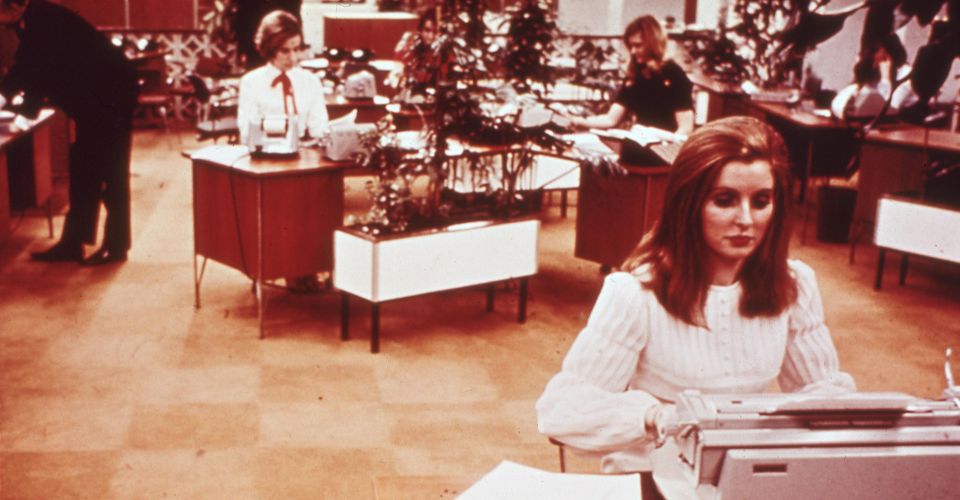
Workplaces in the 1970s featured central, open-plan areas as well as cellular offices.
1970s – A Decade of Bold Changes
Whatever you think about 1970s design, it certainly was distinctive. According to Chip DeGrace, Interface director of design purpose, solid-color, residential-quality broadloom carpet, corduroy, plastic, and vinyl were all the rage in the ‘70s office, as were mod furniture and bold colors like avocado green and orange accents.
The ‘70s also marked the emergence of the cellular office, says Laura Light, Interface concept design team leader. Experimental, open-office landscapes were fading as workers desired more individual control over heating, noise and ventilation, and recognition of employee rights became more common. You saw the rise of individual cellular offices along a building’s perimeter – often reserved for senior roles – while junior and administrative positions continued to work from open-plan workspaces in the middle of the building.
“This is where fusion-bonded carpet tiles appeared in the mainstream, to address the changing needs of the commercial environment,” says Light. With modular carpet in the 1970s consisting of single-color tiles, true floor “designs” were limited; instead, offices were drawn to the functional benefits of carpet tile and the flexibility it brought to spaces.
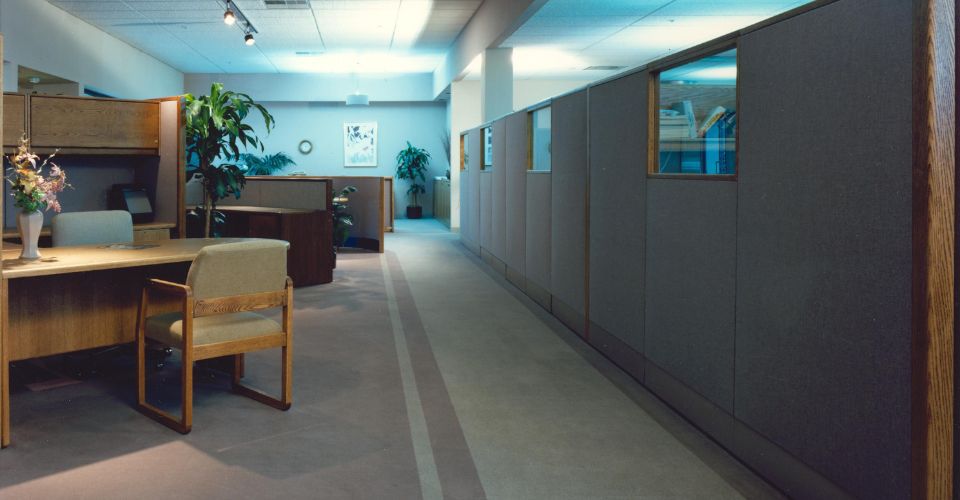
Offices in the 1980s incorporated cubicles along with privacy screens and storage.
1980s – Privacy Becomes a Priority
By the ‘80s, the cellular/open-plan combination model remained prevalent, but with technology rapidly changing, workspaces had to be more flexible and efficient. The 1980s were less about people and their needs, however. There were hierarchical office sizes, and employees worked from the cubicle their job required. Global office floor plans became larger, requiring floors and ceilings to assist in user wayfinding.
“Office furniture really started to change, in terms of ergonomics and user-driven needs,” Light continues. “Herman Miller started to develop static ‘system furniture,’ which adopted personal panel screens and storage within the open plan.”
In addition, the increased use of personal computers, printers, and fax machines meant offices needed to be designed to house cables, which led buildings to incorporate raised access floors and suspended ceilings.
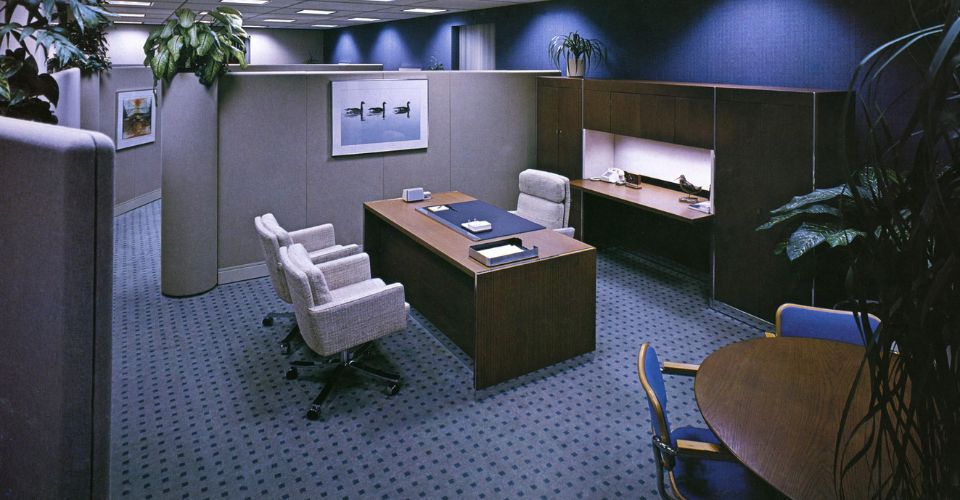
During the 1990s, modular furniture and flooring facilitated flexibility in workspaces.
1990s – A More Connected World
As offices increasingly connected to the internet, computers became a necessity for most employees, and according to DeGrace, “lighting, seating and private spaces were all changing to accommodate the need to focus on screens.”
The introduction of laptops and mobile phones provided more freedom to office workers. This facilitated a greater emphasis on collaboration within office environments.
“Furniture became more modular as companies looked to increase flexibility within their workspaces. Because modular furniture is designed to be reconfigured, it enabled offices to adapt their layouts quickly and easily as team needs and employee preferences changed,” says Light.
Modular flooring also changed during this time as manufacturing advancements enabled a greater variety of colors and patterns to be offered to businesses. While the functionality of carpet tile remained a primary driver, flooring aesthetics had a greater influence on product selection.
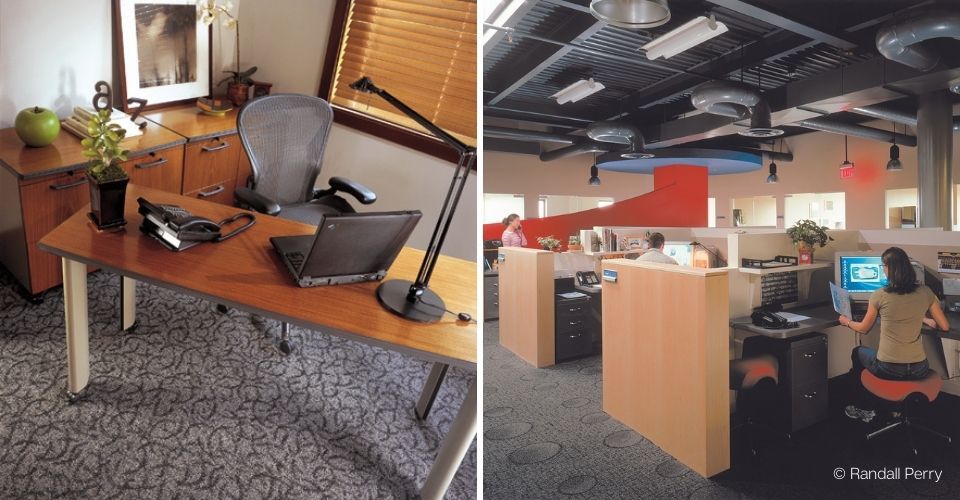
Technology advances influenced office designs during the 2000s.
2000s – New Millennium, New Ways of Working
The start of a new millennium also introduced the idea of agile working – thanks to the swift development of all things tech. Mobile phones and laptops became common (and smaller). With increased focus on digital storage, desk sizes also decreased. During this period, many workplaces also became more casual – in terms of attitude, attire, and design.
“Design began to change where you’d find other industrial materials exposed, like brickwork and air ducts,” says Light. “People were looking for a more casual feel to encourage personalized spaces. These spaces were suited to the long hours of workers spending their time doing desk-based work using a personal computer.”
The 2000s were also when businesses first began to consider the idea of workplace wellness – both with respect to people and the planet. “Biophilia and sustainability took hold with natural and recycled materials becoming part of the design,” says DeGrace.
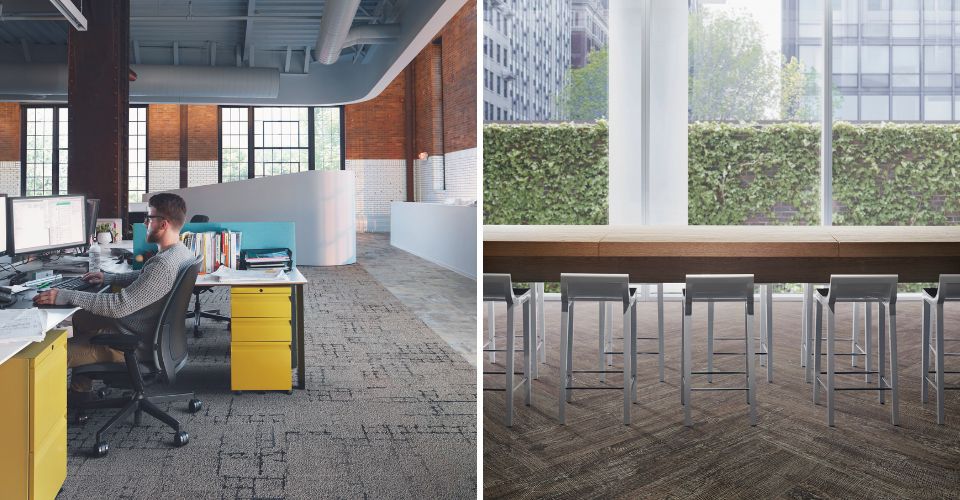
In the 2010s, biophilic-inspired materials began to be seen in the workplace as companies considered employee wellbeing in their office designs.
2010s – Designing for Employees
By the 2010s, a new generation of employees were embarking on their own careers, and the business world soon realized they needed to prioritize the employee experience to attract and retain talent.
“With millennials expecting more from their workplace, companies started to take a more proactive role in improving the wellbeing of their employees,” says Light. “Employers added more features like cafés and casual seating, or perks like game rooms and fitness facilities, to draw employees in, and to represent their culture or brand.”
Interface Design Director Mandy Leeming agrees: “There is more focus on feeling comfortable in the workplace, with things such as standing desks, comfy seating, and remote working having been introduced in recent years to keep staff happy and motivated.”
As the effort to promote employee wellbeing grew, biophilic design gained even greater traction in office environments. Check out our first report on this topic to learn more: Human Spaces: The Global Impact of Biophilic Design in the Workplace.
Many workplaces revisited the idea of open-plan formats, allowing more employees to experience daylight from exterior windows, and Interface’s introduction of nature-inspired patterns, like Human Connections™ carpet tile and Textured Woodgrains™ LVT, helped offices bring the outdoors into interior spaces. Designers also began to select flooring based on the space-specific needs of their project, leading hard surfaces to become increasingly popular in high-traffic areas like corridors and break rooms.
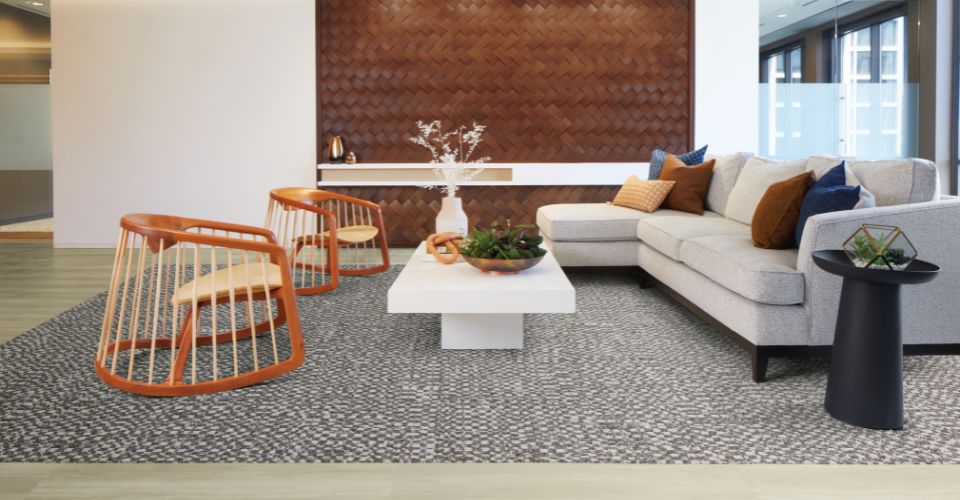
In the wake of Covid-19, many companies are incorporating residential elements into their office designs.
Today – Redefining the Role of the Workplace
The first years of the 2020s have been years of uncertainty. It’s clear that the COVID-19 pandemic has had a lasting impact on office designs, and there continues to be a lot of speculation about how offices will be used in the future. Now that employees have returned to the office following months of working from home, it’s no surprise that we’re seeing an emphasis on comfort in the workplace.
Interface Associate Creative Director Katherine Cohen says that residential materials are being brought into commercial spaces. “Both rattan and cane have been brought into workplaces via room dividers, office chairs, or inspired upholstery motifs. I have also seen more and more offices using rugs as pure design accents. Offices are embracing form over function like choices often made in residential interiors.”
But, DeGrace cautions that the office should have a distinct purpose. “The office doesn’t want to be like a home. We don’t need blurring of the lines between home and work; we need greater specificity in what makes the design of each appropriate.”
With the rise of hybrid approaches, many companies, including Interface, are designing their offices for flexibility and collaboration. Companies are using modular flooring to define collaboration areas, to communicate wayfinding, and to convey the intention of spaces. Bright, invigorating colors and patterns are being used to denote areas for conversation and creativity, while more subdued looks may promote quiet, focused work.
The Next 50 Years
Will this emphasis on hybrid work continue? Will the adoption of new technologies revolutionize offices again as it did in the past? While it’s impossible to predict exactly what comes next, many interior designers and their clients are creating the offices of today with the need for future flexibility in mind.